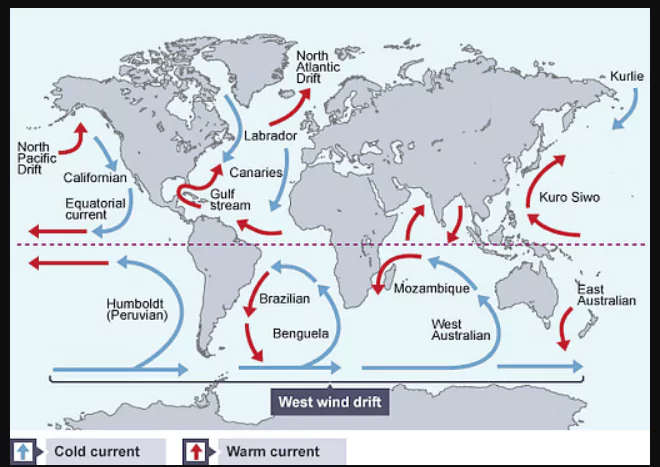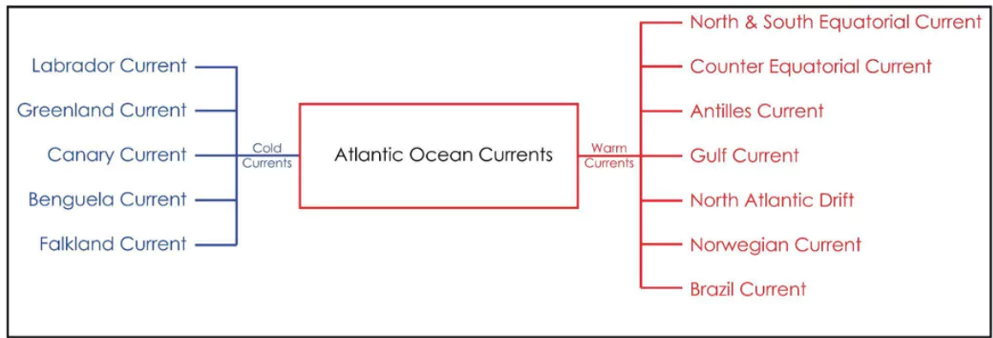Ocean currents are like large masses of water flowing constantly in regular patterns on the ocean surface in definite directions. They’re driven by various forces like winds, temperature, and even the Earth’s rotation. These currents play a crucial role in shaping Earth’s climate, influencing everything from temperature patterns to marine life habitats. Understanding them helps us grasp the complex dynamics of our planet’s oceans.
Ocean Currents and Their Influence
Factors Influencing Ocean Currents
- Insolation: Heating expands water, creating a downhill gradient; Equator water is about 8 cm higher than mid-latitudes.
- Winds: Push the ocean water to move due to surface friction.
- Trade Winds: North-East Trade Winds move North Equatorial Current, Florida Current; South-East Trade Winds drive South Equatorial Current, warming Brazil’s eastern coast.
- Westerlies: Southern Hemisphere’s Westerlies drive West Wind Drift, forming Peruvian and Benguela Current.
- Monsoon Winds: In Northern Indian Ocean, currents change with North-east (winter) and South-west (summer) monsoon winds.
- Gravity: Gravity tends to pull the water down the pile and create gradient variation; Influences tides and periodic sea level changes.
- Coriolis Force: causes the water to move to the right (clockwise) in the northern and to the left (anticlockwise) in the southern hemisphere, creating circular movements of water in the form of gyres.
- Temperature: Warm equatorial water rises and moves poleward;
- Cold polar water creeps along the sea bottom towards the equator.
- Salinity: Higher salinity water flows below less saline water; In the Mediterranean, less saline Atlantic water flows in, compensated by denser bottom water outflow.
- Water with high salinity or colder in nature is denser and hence tends to sink.
- Land: Land acts as a barrier, deflects currents, influences speed and direction; Southern Chile’s tip diverts West Wind Drift as Peruvian Current northwards.
- Underwater Topography: Ocean floor shapes guide and redirect currents.
- Thermohaline Circulation: Combined effect of temperature and salinity; forms distinct water masses with specific density characteristics that drive the ocean ciculations across depths.
Enroll now for UPSC Online Course
Types of Ocean Currents
Based on Depth
- Surface Currents (upper 400m of the ocean): Constitute about 10 percent of all the water in the ocean.
- Deep Water currents: Constitute 90 percent of the ocean water. These waters move around the ocean basins due to variations in density and gravity.
- Deep waters sink into the deep ocean basins at high latitudes, where the temperatures are cold enough to cause the density to increase.
Based on Temperature
- Warm Current: Generally, they originate near the equator and move towards the poles; usually observed on the east coast of continents in the low and middle latitudes (true in both hemispheres).
- In the northern hemisphere, they are found on the west coasts in high latitudes.
- Cold Ocean Currents: The cold currents carry water from polar or higher latitudes to tropical or lower latitudes;
- Usually found on the west coast of the continents in the low and middle latitudes (true in both hemispheres) and on the east coast in the higher latitudes in the Northern Hemisphere. [UPSC 2021]

| Eastward flow of equatorial counter-current: Trade winds push the water towards the west but land masses on the west obstruct the flow. A gradient develops there and water starts moving towards the east under its influence as the influence of winds is not significant due to the presence of doldrums.[UPSC 2015] |
- Gyres: Vast circular system made up of ocean currents that spiral about a central point. Clockwise in the Northern Hemisphere & Anti clockwise in the Southern Hemisphere.
- Five Major Gyres: North Pacific Subtropical, South Pacific Subtropical, North Atlantic Subtropical, South Atlantic Subtropical and Indian Ocean Subtropical Gyre.
Pacific Ocean Currents
| Warm Current |
Cold Current |
- Kuroshio Current
- North Equatorial Current
- South Equatorial Current
- East Australian Current
- Alaska Current
|
- California Current
- Oyashio Current
- Peru Current
- Humboldt Current
- West Wind Drift
|
Atlantic Ocean Currents
- Norwegian Current(Warm): Keeps oceans to the north of Norway free from ice.
- Labrador Current (Cold): Its confluence with the warm Gulf Stream creates a rich fishing ground on the northeast coast of North America (Grand Bank).

Indian Ocean Currents
- Warm and Stable: South Equatorial Current; Mozambique Current; Agulhas Current
- Warm and Unstable: S-W Monsoon Current; N-E Monsoon Current; Somali Current
- Cold and Stable: West Australian Current
Effects of Ocean Currents
- Temperature Variation:
- Coasts with cold currents, like west coasts of continents in tropical and subtropical regions, experience low temperatures with signs of aridity.
- West coasts of the continents in the middle and higher latitudes are bordered by warm waters, which experience a distinct marine climate with cool summers and mild winters.
- Productive Fishing Grounds: Areas where the warm and cold currents meet provide the best fishing grounds in the world [UPSC 2013].
- Example: Seas around Japan and the eastern coast of North America.
- These areas also experience foggy weather making it difficult for navigation.
- Desert Formation: High aridity due to cold ocean currents in west coast regions of the tropical and subtropical continents.
- Example: Peru Current, also called Humboldt Current, is a cold-water current of the southeast Pacific Ocean and the reason for the aridity of the Atacama desert. It is the driest desert in the world.
Enroll now for UPSC Online Classes
Conclusion
- Ocean currents are the lifeblood of Earth’s oceans, shaping climates, influencing weather patterns, and supporting diverse ecosystems.
- From the warm currents near the equator to the cold currents from polar regions, each current has its own story to tell.
- By studying these currents, we gain insights into the interconnectedness of Earth’s systems and the delicate balance of our planet’s environment.
![]() May 1, 2024
May 1, 2024
![]() 8481
8481
![]() 0
0

